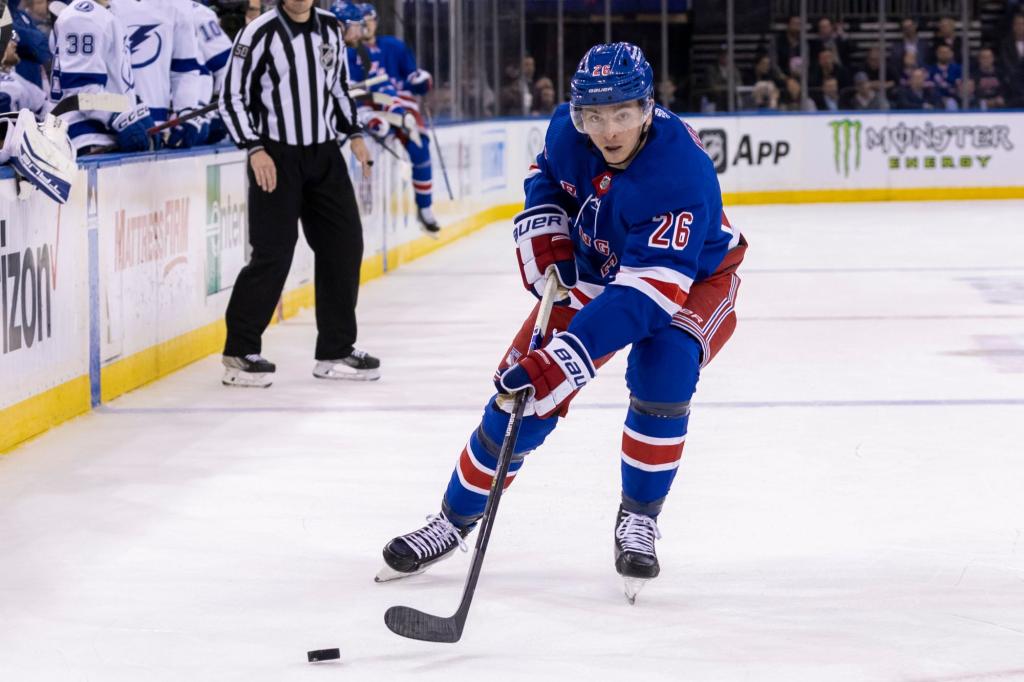As strictly defined, nobody has done a better job than the Rangers’ fourth line that is tasked with protecting leads if you pay no attention to the analytics behind the curtain.
For the simple truth is that the unit centered by Nick Bonino with Barclay Goodrow and Jimmy Vesey on the flanks had not been on the ice for a goal against in 46:22 of five-on-five work entering Thursday’s Garden match against the Hurricanes.
But whether that is the truth, the whole truth and nothing but the truth will be left up to the jury that will sift through evidence proving that the Blueshirts’ fourth line ranks 70th and last in xGF at 15.6 percent among forward units with at least 40:00 of ice time while also ranking 70th and last in shot attempts share at 26.5 percent, per MoneyPuck.
The Bonino line has been caved in. Anaheim’s trio of Ross Johnston, Sam Carrick and Brett Leason is next-to-last in xGF at a comparatively whopping 25.7 percent. And Detroit’s line of Michael Rasmussen, J.T. Compher and Andrew Copp is next-to-last in attempts share at a relatively overwhelming 32.6 percent.
Still — no goals against.
And no goals for any of the Blueshirts’ fourth-liners with the two assists credited to Vesey the only points awarded the unit that does have a defensive zone 92.59 percent faceoff rate, per NaturalStatTrick.
“I think we’re a good defensive unit. We’ve pretty much explicitly been used in that role,” Vesey told The Post hours before the Blueshirts put their five-game winning streak on the line. “We defend hard. We block shots. I don’t believe we have given up a goal with the three of us on the ice together.
“The challenge for us going forward is that we’re starting in the D-zone all the time or our half of the neutral zone, how are we going to play offense, which I think we need to do more of. That’s the biggest challenge we face but in terms of our line, I think we’ve been valuable to our team killing penalties and defending but we can’t spend as much time in the D-zone.”

Indeed, Goodrow, Bonino and Vesey comprise half of the club’s penalty-kill forwards in joining Mika Zibanejad, Chris Kreider and Vincent Trocheck for the bulk of the duty. The unit killed 17 of 18 power plays while sweeping the five-game road trip.
So there is that value, too. Still, it’s not only Vesey — who was scratched for two of the first three games in favor of Tyler Pitlick but has been in the lineup for seven straight — who would like to see the unit generate more O-zone possession time and scoring opportunities. That would reflect head coach Peter Laviolette’s view, as well.
“The [D-zone] starts makes it a little tougher but that [doesn’t include] all the time you jump over the boards on the fly, maybe 55 or 60 percent of changes, but that’s right, I see where I’m putting them,” Laviolette said. “I do think they’re good, responsible defensive players.
“Like everybody, do I think that the fourth line can push to the offensive zone and generate more? Would I like that? I would, but I would also like to see that from all of our lines, not just that one.
“It is tougher duty, it is more difficult for [the fourth line] to get there,” said the coach. “When they get there I would like to see them generate more but I would like to see all of our lines and defensemen try to figure out a way to get more in the offensive zone.”
A year ago, Vesey earned a one-year contract for $750,000 off an impressive training camp tryout and then earned a two-year extension the first week of January at $800,000 per off an excellent opening three months in which the prodigal No. 26 was elevated to top-six and top-nine duty on a routine basis.
This year, though, Vesey was in street clothes for the opener and then again for the third game. But not since.
“I didn’t interpret [the scratches] as a message. I thought I had a good camp and came in better physically positioned than last year. We do a timed sprint on the ice and I was faster,” said the 30-year-old winger. “I think it was just a numbers thing.
“Nobody wants to sit out and not play so when you get back in there’s a little more urgency. But if you look at my season last year, it started the same way. It took a while for me to score my first goal [in Game 11] and then it just kind of snowballed.
“Personally I’m looking for a moment like that to build on and so is our line,” Vesey said. “We’re still trying to jell, I’ll say, but when we are forechecking and the puck is down there I think we are very close to coming up big in these spots offensively, too.”
Source









